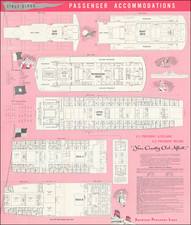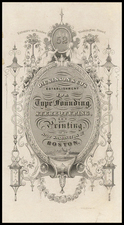A fine example of the first illustrated leaf of the 'Nuremberg Chronicle' (1493), the most famous 'Incunabula' book, depiciting the The Lord commencing 'Genesis'.
This exquisitely executed woodcut depicts The Lord, represented in the manner of a wise King-Bishop, enthroned with regalia and surrounded by a sumptuous pageant of allegory. Being the first illustrated leaf from the Nuremberg Chronicle, the image is meant to symbolically show The Lord commencing the story of Genesis, or his divine creation of the World. The immense power of this imagery had few peers in the corpus of early printing.
The lines written across the ribbons above The Lord are from Psalm 33 (renumbered since 1493 from Psalm 32):
"Ipse dixit et facta sunt. Ipse mandavit et creata sunt."
[Translated: "He spoke and it was there. He commanded and they were created."]
These lines were treasured in early modern art and most notably, they are also inscirbed on the back panels of Hieronymous Bosch's masterpiece, The Garden of Earthly Delights (c.1500).
The Nuremberg Chronicle is by far the most famous and largest "Incunabula" (pre-1500 book). The text was written by the humanist scholar Hartmann Schedel (1440-1514) and first appeared in a Latin language edition, Liber Chronicarum (Book of Chronicles). It was closely followed by a German language edition, known as the Die Schedelsche Weltchronik (Schedel's World History), both printed by Anton Koberger, in Nuremberg, in 1493. The work is an illustrated biblical paraphrase and world history that follows the story of human history related in the Bible; it includes the histories of a number of important western cities and many fine maps and town views.
The Chronicle is celebrated as the earliest book to successfully integrate illustrations and text and it featured an astounding 1,809 woodcut illustrations. The artwork was prepared in the large workshop of Michael Wolgemut (1434-1519), then Nuremberg's leading artist, whose establishment employed the young Albert Dürer (1471-1528). He was soon to become the greatest artist of the Northern Renaissance, who was responsible for some of the Chronicle's illustrations.
As the first illustrated leaf of the Nuremberg Chronicle, the present woodcut is especially prized by collectors.
Hartmann Schedel (1440-1514) was a physician, book collector, and writer whose most famous work, the Liber Chronicarum (Nuremberg Chronicle), included some of the first printed views of many cities in Europe and across the world.
Schedel was born and died in Nuremberg, but he also traveled for his education. From 1456 to 1463 he lived in Leipzig, where he attended the University of Leipzig and earned his MA. From there he went to Padua, where he earned a Doctor of Medicine in 1466. After university, he worked for a time in Nördlingen and then returned to Nuremberg. In 1482 he was elected a member of the Great Council of Nuremberg.
The Chronicle was published in 1493. Besides this major work, one of Schedel’s most enduring legacies is his magnificent manuscript and printed book collection, one of the largest of the fifteenth century. In 1552, Schedel's grandson, Melchior Schedel, sold about 370 manuscripts and 600 printed works from Hartmann Schedel's library to Johann Jakob Fugger. Fugger later sold his library to Duke Albert V of Bavaria in 1571. This library is now mostly preserved in the Bayerische Staasbibliothek in Munich.
Among the surviving portions of Schedel's library are the records for the publication of the Chronicle, including Schedel's contract with Anton Koberger for the publication of the work and the financing of the work by Sebald Schreyer and Sebastian Kammermeister, as well as the contracts with Wohlgemut and Pleydenwurff for the original artworks and engravings. The collection also includes original manuscript copies of the work in Latin and German.









![[Title page -- Book of Martyrs] Acts and Monuments of Matters Most speciall and memorable, happening in the Church, with an universall Historie of same . . . 1632](https://storage.googleapis.com/raremaps/img/small/79484.jpg)

![[Historical Time Line Map -- Creation To 100 AD] Tableau de L'Histoire Sainte Depuis La Creation du monde jusqu'a la dispersion du Juifs . . .](https://storage.googleapis.com/raremaps/img/small/82069.jpg)
![[Whoever is silent is Complicit -- Anti-Vietnam / Anti-American Poster] Vietnam: Sterminio | chi tace è complice](https://storage.googleapis.com/raremaps/img/small/89365.jpg)
![[ Confederate States of America Naval Flag! ] Pavillons des Principales Puissances](https://storage.googleapis.com/raremaps/img/small/88973.jpg)
